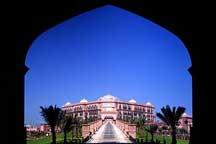"Loulan Beauty" unearthed, but still sleeps eternal slumber
2009-05-22 17:46 BJT
When the coffin's millennia-old cowhide bindings made an audible snap as they broke free in late 2004, Yidilisi Abuduresule felt tears well up in his eyes and could almost hear a voice from 3,800 years ago.
"It is the most beautiful sound I have ever heard in my life - those of steps made through history," said the head of the Xinjiang Cultural Relics and Archaeology Institute.
A young woman with her permanent smile finally met the world after thousands of years of sleep - and the first mummy found in the Xiaohe cemetery surprised the world. Now known as the Loulan Beauty, she lies peacefully in the local museum.
Abuduresule knows well about footsteps. He has been in the Taklimakan Desert, "sea of death", and made scores of times over the past 30 years in search of ancient tombs.
Today some 2,000 tourists from all over the world come to Xinjiang Uygur Autonomous Region Museum each day to see the Loulan Beauty.
This October, Belgium will host part of the collection, said Anniwar Kasim, director of the museum's vault. The Loulan Beauty and other cultural relics have already been to Japan, the US, Germany and other countries.
Due to Xinjiang's arid climate, deep sands, long hours of sunshine and wide ranging temperatures, bodies of ancient people have been well preserved for thousands of years, providing valuable insights into the region's history and culture.
Foreigners are often interested in the ancient Silk Road, which is represented by artifacts in the museum. They come and imagine the hardships their forefathers endured, the director said.
The Xinjiang museum is the only comprehensive provincial museum in the region, with a collection of more than 40,000 cultural relics and specimens. Ten percent of them are classified as first-grade State cultural relics.
The museum officially opened in 1959 and was rebuilt in 2005 with a total area of 17,228 sq m. It has staged more than 80 exhibitions in Beijing, Shanghai, Hong Kong, Macao and abroad.
"Nearly 1 billion yuan was invested in the construction and since March 28 last year, and the museum has been free of charge," Kasim said.
The museum's five sections represent grassland culture of the western regions, dresses and adornments of ancient western regions, Buddhist art of Xinjiang, the ancient mummies of Xinjiang and ethnic customs.
"Our museum is an epitome of Xinjiang history," Kasim smiled.
The displays help tourists know more about the history and culture of various ethnic groups, he said, adding that the government is funding preservation of the collection with 126.9 million yuan this year.
Abuduresule said he is optimistic about protecting the Xiaohe cemetery. After the tomb was unearthed, its support pillars were reinforced with steel bars and two or three watchmen are on station around the clock.
Editor: Yang Jie | Source:
 Mail
Mail Share
Share Print
Print


 Video
Video









 2009 China Central Television. All Rights Reserved
2009 China Central Television. All Rights Reserved